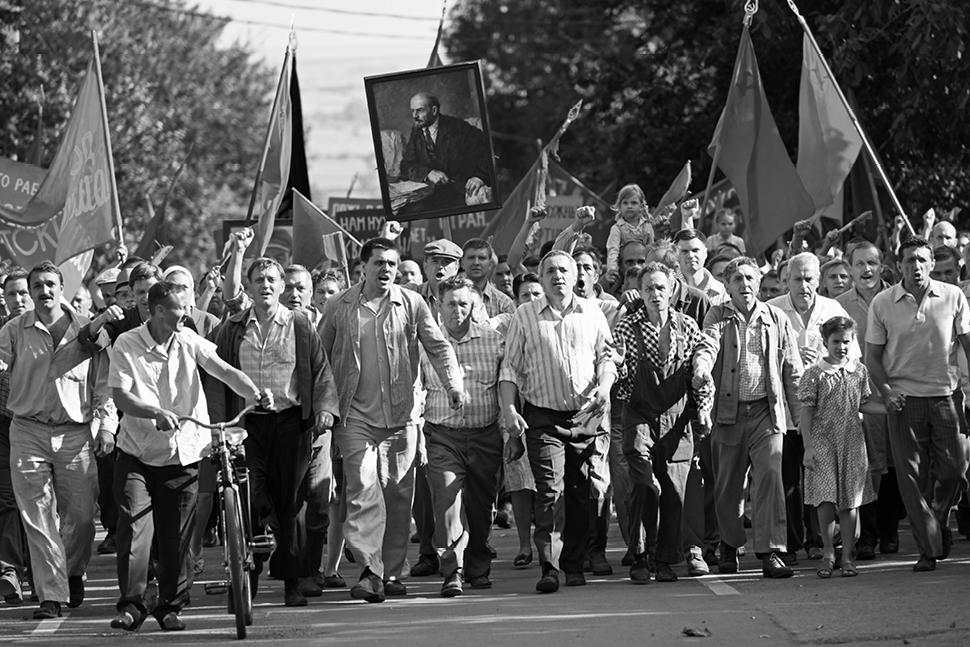"Dorogie Tovarischi!" by Andrey Konchalovskiy: An Overturned Revolution

Soon after watching this movie, a question arises: why has Andrey Konchalovsky made a film about denunciation and civil commitment now? Why has he done it by staging an episode about the massacre in the city of Novocherkassk, which took place in 1962, during the Khrushchev years, and had been kept secret for almost 30 years.
In June of 1962, the Soviet army opened fire on striking factory workers, leaving dozens dead or wounded. More than one hundred others were arrested, accused of instigating riots, and imprisoned, with 7 people even receiving death sentences.
After the massacre, there was so much blood that the streets had to be repaved. The event had been covered up by the authorities until Perestroika.
Now that all the eyewitnesses have died, it is left to the artists to recall this memory. Konchalovsky has decided to tell this story by focusing on the hidden aspect of it, a technique that is common in all totalitarian regimes in history.
Moreover, Konchalosky shows what happened at the border of the empire, hinting at the unsolved problems of today’s Russia. He makes a reversal of the revolution through precise references to the history of Soviet cinema.
He works on the overthrow of the revolutionary Soviet cinema, telling it like a revolution overthrow, such as the command to open fire on workers in a communist country.
It is not a coincidence that the movie begins with a sequence about a strike, a strike against the Soviet state itself, represented in the film by the directives, which imposed an increase in production quotas and concurrent increases in meat and dairy prices. In the impressive mass strike sequence, the workers raise Lenin’s portrait and banners (while inside the town hall, one of the politicians says, “they are bringing Lenin against the Soviet State”).
In addition to the key sequence of the strike in the movie, there is a typical character of the Soviet cinema: the mother. She is the protagonist of the story (played by Yuliya Vysotskaya, the director’s wife, who also starred in Paradise), searching for her daughter who had gone missing after participating in the protests.
She is a mother and a party leader (with Stalin), despite the 1961 resolution of the 22nd Congress of the Party which she had not had time to digest and undergoes a kind of ideological change when repression touches her personally. She accepts the help of a KGB agent, the agency which turns out to be responsible for the massacre.
The KGB agent is a controversial figure in the film. He goes from being an inflexible inquisitor to being a supportive and caring companion; a character who recalls the figure of Gorge Zozhonov, an actor and writer who, after fifteen years in the gulag, returned to Russian cinema, playing KGB agents.
The purity of the black and white of the movie is a format that recalls films of that period; the 4/3 immediately brings back the cinema of the sixties. It is no longer the revolutionary cinema suggested at the beginning of the film, with figures such as workers, mothers and Cossacks, but the one of the Khrushchev-era thaw which recommended comedies and optimism (through the televisions in homes, you could hear choruses and songs).
It is around the time of the Novocherkassk massacre that two friends and collaborators, Tarkovsky and Konchalovsky made their first steps into cinema: Konchalovsky co-wrote the screenplays of The Steamroller and The Violin and Ivan’s Childhood, both later directed by Tarkovsky. Konchalovsky made his directorial debut in 1961 with the short The Boy and the Dove (Malchik i golub), and made his first feature, The First Teacher, in 1965.
There was a time when the two artists were able to witness a crowded room of sixty enthusiastic people at the Polish embassy, watching Ashes and Diamonds by Andrzej Wajda, a rather anti-Stalinist movie which, as Konchalovsky once said, was a film “that changed my way of thinking as much as Khrushchev’s speech at the 20th Congress.”
Silvana Silvestri
© FIPRESCI 2020
Translated from Italian by Rita Di Santo
Edited by Malwina Grochowska
